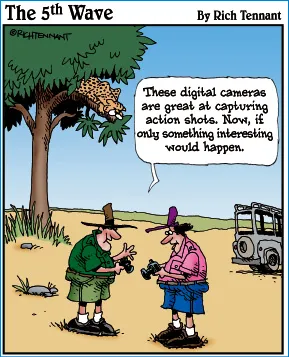Making sense of all the controls on your D3000 isn’t something you can do in an afternoon — heck, in a week, or maybe even a month. But that doesn’t mean that you can’t take great pictures today. By using your camera’s automatic point-and-shoot modes, you can capture terrific images with very little effort. All you do is compose the scene, and the camera takes care of almost everything else.
This part shows you how to take best advantage of your camera’s automatic features and also addresses some basic setup steps, such as adjusting the viewfinder to your eyesight and getting familiar with the camera menus, buttons, and dials. In addition, chapters in this part explain how to obtain the very best picture quality, whether you shoot in an automatic or manual mode, and how to use your camera’s picture-playback features.
1
Getting the Lay of the Land
In This Chapter
Attaching and using an SLR lens
Adjusting the viewfinder to your eyesight
Working with memory cards
Selecting from menus
Using the Shooting Information and Quick Settings displays
Viewing onscreen help
Customizing basic operations
I still remember the day that I bought my first SLR film camera. I was excited to finally move up from my one-button point-and-shoot camera, but I was a little anxious, too. My new pride and joy sported several unfamiliar buttons and dials, and the explanations in the camera manual clearly were written for someone with an engineering degree. And then there was the whole business of attaching the lens to the camera, an entirely new task for me. I saved up my pennies a long time for that camera — what if my inexperience caused me to damage the thing before I even shot my first pictures?
You may be feeling similarly insecure if your Nikon D3000 is your first SLR, although some of the buttons on the camera back may look familiar if you’ve previously used a digital point-and-shoot camera. If your D3000 is both your first SLR and first digital camera, you may be doubly intimidated.
Trust me, though, that your camera isn’t nearly as complicated as its exterior makes it appear. With a little practice and the help of this chapter, which introduces you to each external control, you’ll quickly become as comfortable with your camera’s buttons and dials as you are with the ones on your car’s dashboard. This chapter also guides you through the process of mounting and using an SLR lens, working with memory cards, navigating your camera’s menus, and customizing basic camera operations.
Getting Comfortable with Your Lens
One of the biggest differences between a point-and-shoot camera and an SLR (single-lens reflex) camera is the lens. With an SLR, you can swap out lenses to suit different photographic needs, going from a macro lens, which enables you to shoot extreme close-ups, to a wide-angle lens, which encompasses a wide field of view, to a telephoto lens, which lets you photograph subjects from a distance. In addition, an SLR lens has a movable focusing ring that gives you the option of focusing manually instead of relying on the camera’s autofocus mechanism.
Of course, those added capabilities mean that you need a little background information to take full advantage of your lens. To that end, the next several sections explain the process of attaching, removing, and using this critical part of your camera.
Attaching a lens
Your camera can autofocus only with a type of lens that carries the specification AF-S. (Well, technically speaking, the camera can also autofocus with AF-I lenses. But since those are high-end, very expensive lenses that are no longer made, this is the only mention you’ll find of AF-I lenses in this book.) You can use other types of lenses, as long as they’re compatible with the camera’s lens mount, but you’ll have to focus manually. Whatever lens you choose, follow these steps to attach it to the camera body:
1. Turn the camera off and remove the cap that covers the lens mount on the front of the camera.
2. Remove the cap that covers the back of the lens.
3. Hold the lens in front of the camera so that the little white dot on the lens aligns with the matching dot on the camera body.
Official photography lingo uses the term mounting index instead of little white dot. Either way, you can see the markings in question in Figure 1-1.
Note that the figure (and others in this book) shows the D3000 with its so-called “kit lens” — the 18–55mm AF-S Vibration Reduction (VR) zoom lens that Nikon sells as a unit with the body. If you buy a lens from a manufacturer other than Nikon, your dot may be red or some other color, so check the lens instruction manual.
4. Keeping the dots aligned, position the lens on the camera’s lens mount as shown in Figure 1-1.
When you do so, grip the lens by its back collar, not the movable, forward end of the lens barrel.
5. Turn the lens in a counterclockwise direction until the lens clicks into place.
To put it another way, turn the lens toward the side o...






